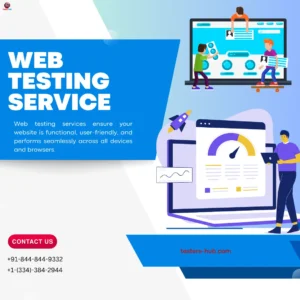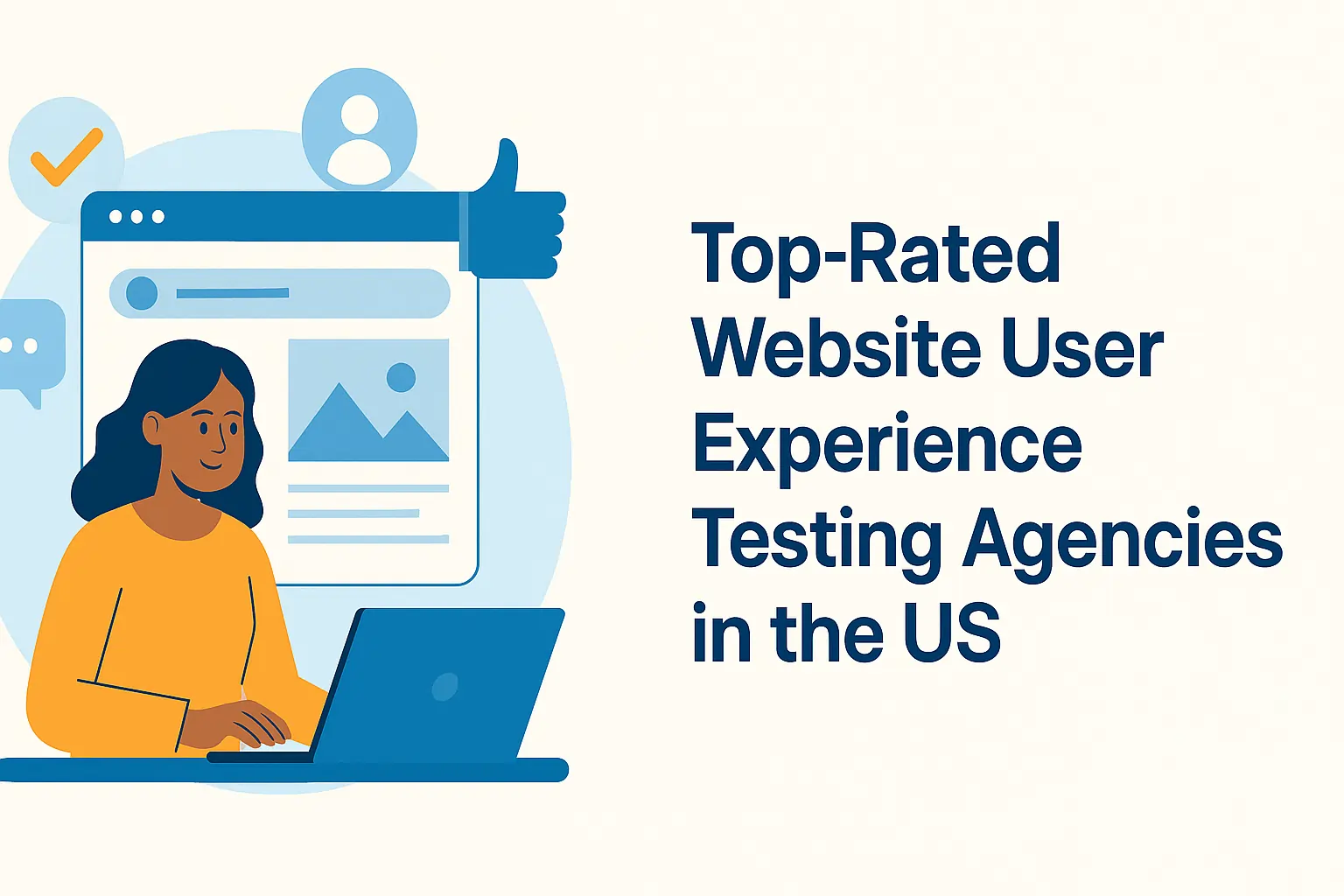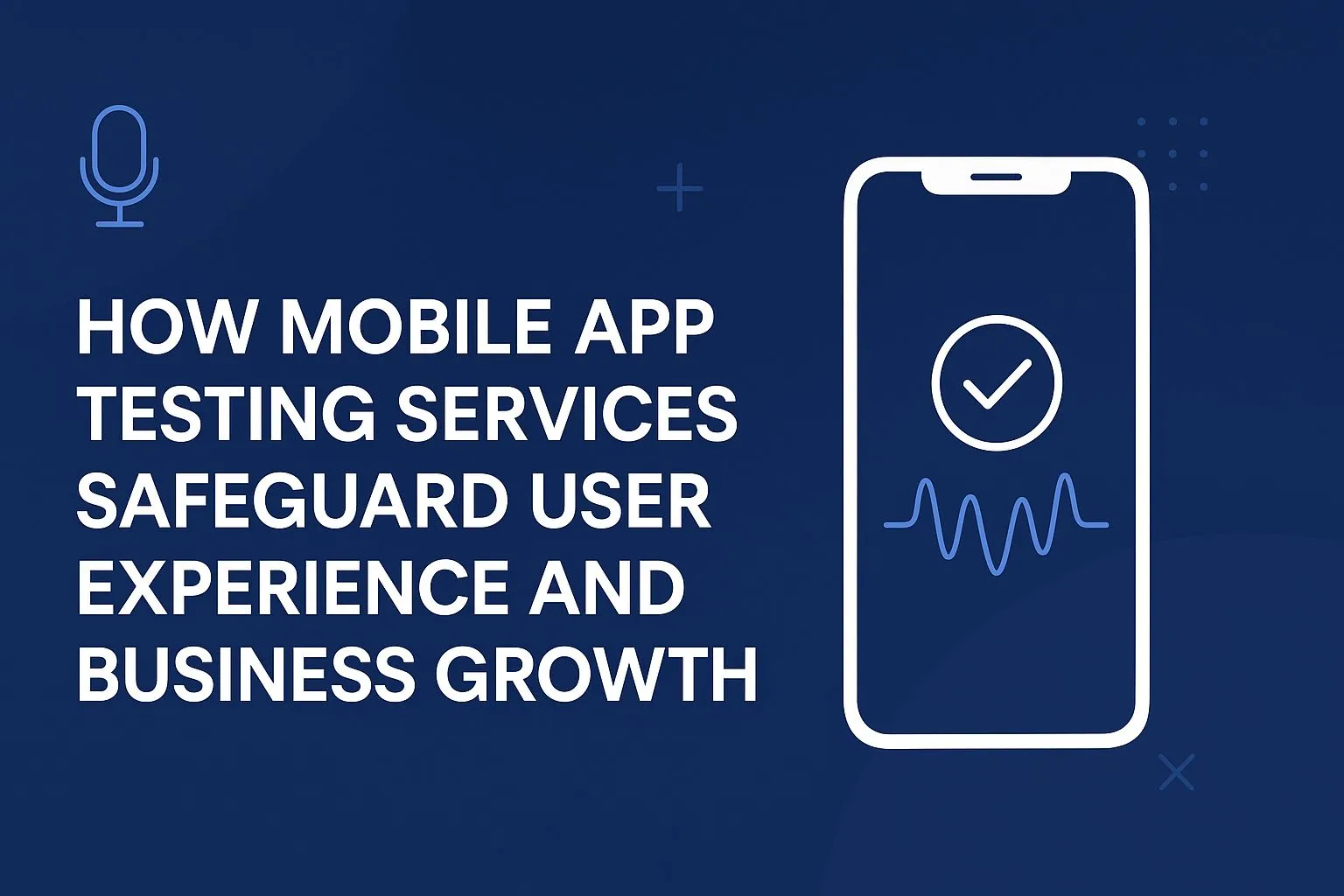How to Test Your Website’s Usability Using Web Testing Services
Web testing services are essential for ensuring a seamless user experience on your website. Conducting website usability testing services helps optimize the design, navigation, and functionality of your site. By using user experience testing and engaging with website usability testing services, businesses can identify and resolve issues that may hinder user engagement. Website usability testing companies and web app testing services provide the necessary tools to test across various platforms and browsers, ensuring compatibility and performance. With the support of web testing services, you can assess your site’s usability and enhance user retention and satisfaction. Whether through QA web testing or web application testing services, these solutions ensure an intuitive experience, leading to improved user interactions and increased conversions.

1. What Is Website Usability Testing?
Website usability testing involves evaluating the overall user experience (UX) of your site by observing how users interact with it. This process identifies potential issues, hindrances, or complexities that could affect a user’s ability to navigate and use the site effectively. It aims to improve the site’s structure, design, and overall function, ensuring visitors can easily achieve their goals.
Importance of Website Usability Testing
Website testing sites offer a thorough evaluation of a site’s design, focusing on user experience testing (UX testing). By using web usability testing services, businesses can pinpoint usability barriers and rectify them to create a more accessible and enjoyable experience for their users.
When users struggle to navigate through a site or complete actions like purchasing or signing up, it directly impacts your business. Proper usability testing ensures that the site is user-friendly, reducing frustration and encouraging higher conversion rates.
Benefits of Usability Testing for Websites
- Improved User Retention: With streamlined navigation and intuitive design, users are more likely to return to your website.
- Higher Conversion Rates: Simplifying the user journey leads to higher chances of users completing desired actions, such as signing up or making a purchase.
- Better Accessibility: Addressing usability concerns makes your website more accessible for people with disabilities, widening your potential audience.
2. Key Web Testing Sites to Consider for Usability Testing
To ensure the effectiveness of website usability testing, selecting the right web testing sites is crucial. These sites offer a range of testing tools and services that analyze various aspects of your website’s user experience, including navigation, responsiveness, and task completion efficiency.
Popular Usability Testing Sites
Some notable usability testing sites offer valuable features like screen recording, user feedback, heatmaps, and click tracking. These tools help you understand where users focus their attention and how they interact with different elements of your site.
Examples of Leading Testing Web Apps:
- UserTesting: Provides real-time video recordings of real users interacting with your website, offering insights into their experience and behavior.
- Lookback.io: Focuses on live user sessions and provides feedback in real time, which is invaluable for rapid iteration.
- Hotjar: Known for its heatmaps, which visually represent areas where users click, scroll, and spend the most time.
By selecting the best website testing service from these platforms, you ensure that your website receives in-depth analysis, offering you detailed insights into what works and what needs improvement.
Why Choose Professional Web Testing Service Providers?
Opting for a professional web testing service provider ensures that your website undergoes a comprehensive and precise evaluation. These specialists go beyond basic usability tests to uncover complex user behaviors and identify potential issues that might otherwise go unnoticed. Their expertise offers deep insights into your site’s performance, enabling you to address areas that need improvement. With their actionable feedback, you can refine your website’s design, functionality, and usability, ultimately providing a smoother, more intuitive user experience. Relying on professionals guarantees that your website operates flawlessly across various devices and browsers, leading to enhanced user satisfaction and higher conversion rates.
3. How to Test Website Usability with Real Users
To ensure a website’s usability, it’s crucial to incorporate real users into the testing process. This type of user experience testing provides genuine feedback, offering insights into how actual visitors navigate the site, where they face challenges, and the reasons behind any abandonment. Real user testing helps determine how well the website functions in a real-world environment, particularly with regard to navigation and overall usability.
Importance of Testing Web Apps and Sites with Real Users
While automated tests are useful, site testing services that involve real users deliver a more authentic view of the user experience. By testing with actual users, you can uncover usability issues that might not be evident during developer-run tests or automated quality assurance processes. This method ensures that your website meets the needs of diverse visitors and provides a true reflection of how your audience interacts with your site.
Key Usability Aspects to Test:
- Navigation: Can users easily navigate through the site without confusion? Testing web app navigation helps identify unnecessary steps or complications.
- Content Clarity: Is the content clear, readable, and engaging? Testing with real users helps assess whether users can easily understand and follow your messaging.
- Visual Appeal: Do users feel comfortable with the overall design? Testing web applications helps ensure the aesthetics are not overwhelming or distracting from the content.
How User Testing Improves Website Functionality
Real user feedback provides the most accurate picture of how your audience interacts with your site. By testing with diverse users, you ensure that every potential user—regardless of background or experience—can interact with your site without encountering issues.
4. Test Website Usability with Cross-Browser and Device Compatibility
Ensuring browser compatibility testing is an essential step in web usability testing. Your website must work seamlessly across different browsers (like Chrome, Firefox, Safari) and devices (such as mobile phones, tablets, and desktops). Cross-browser compatibility testing ensures that your website provides a consistent experience to all users, no matter their choice of browser or device.
The Role of Browser Compatibility in Web Usability
Cross-browser compatibility testing helps you verify whether your website appears and behaves as expected across multiple browsers. Users often face different rendering issues depending on the browser they use, which can negatively affect the user experience.
How Browser Testing Enhances Usability:
- Consistency Across Platforms: Your website should load the same content in the same format, regardless of whether users are accessing it through Chrome or Safari.
- Responsive Design: Mobile users should enjoy the same functionality and user experience as desktop users. Cross-device testing ensures the mobile version of your website is equally optimized for usability.
5. Test Website Usability with a User-Centered Approach
User-centered usability testing emphasizes designing tests that reflect how actual users engage with your website. This approach offers valuable insights into how users interact with your site, complete tasks, and encounter any difficulties or frustrations along the way. By focusing on these real-world experiences, it ensures your website is optimized to meet the practical needs and expectations of its audience.
Why Choose a User-Centered Approach for Website Testing?
A user-centered approach places the user at the heart of the testing process. By modeling tests based on real-life use cases and user interactions, it provides meaningful data that reveals both what works and where improvements are needed. This method ensures that your website testing services are aligned with user expectations, offering a more intuitive and satisfying experience for visitors.
Benefits of User-Centered Testing Services
- Real-World Feedback: Engaging real users through website usability testing services provides actionable insights that automated tools can’t capture. This type of testing reflects how actual visitors use the website, not just how it functions.
- Targeted Improvements: Based on real user feedback, you can make specific improvements to your website, improving areas that cause friction and increasing overall satisfaction with site testing services.
6. Utilize Heatmaps and Session Recordings for Web Usability Testing
Heatmaps and session recordings are invaluable tools in usability testing, providing detailed visual data about user interactions on your website. These insights allow you to identify potential issues that might not be detected through standard testing methods.
Heatmaps: Visualizing User Interaction
A heatmap tracks users’ clicks, scrolling behavior, and mouse movements across your site, revealing which elements attract the most attention. By using heatmaps, you can determine whether users engage with essential content and if other sections of the site go unnoticed.
- Identifying Key Interaction Zones: Heatmaps display both “hot zones,” where users interact most frequently, and “cold zones,” where attention is minimal. This information helps you make informed decisions about content placement and site layout to enhance user engagement.
- Optimizing Navigation: Heatmaps can also highlight navigation issues. For example, if users repeatedly click on elements that are not clickable, it may signal a need to clarify your site’s navigation and design, improving the overall user experience.
Session Recordings: Observing User Behavior in Real-Time
Session recordings capture a user’s entire journey through your website, allowing you to see how they interact with the site in real time.
- Analyze User Problems: Watching a user’s session can reveal friction points—like confusing forms or broken links—that might prevent users from completing tasks.
- Improve User Journey: Session recordings provide a deep look at the user’s behavior, helping you optimize the web application testing service by fixing common user experience issues.
7. Task-Based Testing for Web Usability Testing
Task-based testing involves observing users as they complete predefined tasks on your website, such as filling out a form, making a purchase, or searching for information. This type of web testing service provides insight into how effectively users can complete specific actions.
Benefits of Task-Based Testing for User Experience
- Real-World Testing: This approach tests specific functions that users are likely to use on a day-to-day basis, such as purchasing a product or subscribing to a service. By simulating real-world scenarios, you gain insights into how well users can accomplish goals on your site.
- Problem Identification: It helps to uncover usability issues such as confusing workflows, difficult-to-find features, or inefficient designs. If users are unable to complete tasks or if they need excessive help, this is a sign that your website testing services need improvement.
Key Metrics for Task-Based Usability Testing
- Completion Rate: Measure how many users can complete tasks without errors or confusion. A low completion rate signals a need for improvements in functionality or design.
- Time on Task: Analyzing how long it takes users to complete a task can highlight areas of inefficiency in your website’s design or user flow.
8. Analyze Site Navigation Through Website Usability Testing Services
Ensuring Effective Navigation Through Website Usability Testing
Navigation is a fundamental aspect of website usability. If users have trouble finding the information they need, they are likely to become frustrated and leave your site. Proper navigation testing is essential to ensure your website is user-friendly and logically organized.
Key Areas to Focus on When Testing Navigation:
- Menu Structure: A well-organized menu can significantly impact user experience. During navigation testing, ensure that visitors can easily locate critical sections of your site, such as products, services, and contact details, in an intuitive manner.
- Search Functionality: It’s important that your website’s search feature works efficiently. Users should be able to input keywords and find relevant results quickly. Testing the search functionality within your web app testing services will help to streamline the process and enhance overall usability.
Testing Navigation Flow
- Click Path Analysis: Analyzing the click paths users take to navigate through your site can show if the design is intuitive. For instance, if users click through multiple pages to access the same content, your navigation might need optimization.
- Exit Points: Track where users drop off or leave the site. If users abandon the site at a particular navigation point, it could be an indicator that the layout or information structure is unclear.
9. Mobile Usability Testing for Web Applications
With the increasing reliance on mobile devices for web browsing, mobile usability testing is more important than ever. This testing ensures that your website is fully optimized for mobile users, offering an equally smooth experience on both desktop and mobile.
Importance of Mobile Testing Web App Services for Usability
- Responsive Design: Testing web apps on various devices ensures they automatically adjust to different screen sizes. For instance, a website should look great on a smartphone, tablet, and desktop without requiring users to zoom or scroll excessively.
- Touch Interactions: Mobile usability testing focuses on touch interactions and how easy it is for users to tap, scroll, and interact with the site. Buttons, forms, and links should be optimized for touch-screen devices.
Key Areas to Test on Mobile Devices
- Load Time: Mobile users expect fast-loading websites. Quality assurance website testing can identify performance issues that cause long load times, ensuring your site loads quickly on mobile devices.
- Ease of Navigation: A mobile version of your site should maintain the same ease of navigation that the desktop version offers. Test the layout, readability, and how users can easily navigate between pages and complete tasks.
10. Browser Compatibility Testing for Website Usability
Testing for cross-browser compatibility makes ensuring that your website functions properly across a variety of browsers, including Microsoft Edge, Mozilla Firefox, Safari, and Google Chrome. Regardless of the browser a user is using, a smooth experience is essential.
The Importance of Cross-Browser Testing in Web Usability Testing
Testing for cross-browser compatibility determines whether your website functions and shows uniformly in various browsers. Users might encounter malfunctioning layouts or missing functionality in the absence of this testing, which could result in a subpar user experience.
Common Issues in Cross-Browser Compatibility
- Layout and Styling Issues: Different browsers can render HTML and CSS differently. This may lead to variations in your website’s appearance, such as misaligned elements, text overlap, or buttons that are unresponsive.
- JavaScript and Functionality Problems: Not all browsers handle JavaScript the same way. Certain features or interactive elements might not work properly in specific browsers, leading to usability issues.
Benefits of Website Testing Services for Browser Compatibility
- Seamless User Experience: Ensures that visitors have a consistent, pleasant experience, no matter which browser they use. This can improve user retention and customer satisfaction.
- Wider Audience Reach: By ensuring compatibility with all major browsers, your website can cater to a wider audience, improving overall site accessibility.
11. QA Web Testing for Performance and Usability
The Importance of QA Web Testing: Ensuring Website Performance and Usability
QA web testing is vital in assessing both the performance and usability of a website. By combining performance testing with usability evaluation, it ensures that your site functions optimally across a variety of conditions while providing a seamless user experience.
Why Performance Testing is Essential
Website performance directly impacts user satisfaction. A site that loads slowly or experiences downtime can cause frustration and prompt users to leave. Conducting performance testing, such as load and stress tests, helps identify potential problems before they affect real users.
- Page Load Time: Websites that load slowly can deter visitors. It’s essential to test how quickly your site loads across different devices and network conditions to ensure it’s optimized for all users.
- Stress Testing: This testing simulates high traffic levels to assess how your site handles increased demand. It ensures your website can manage unexpected surges without crashing or slowing down.
Usability Testing for Smooth User Experience
Web usability testing is crucial for evaluating how effortlessly users can interact with your website. This process focuses on aspects such as navigation, content accessibility, and readability, ensuring visitors can easily locate what they need. A website designed with optimal usability enhances user engagement and boosts conversion rates.
- User Journey: A well-structured, intuitive user journey is essential for reducing confusion and improving navigation flow, allowing users to accomplish their goals effortlessly.
- Error Handling: It’s important to ensure that users receive clear and helpful feedback during actions such as form submissions or purchases, minimizing frustration and guiding them through the process smoothly.
12. Browser Compatibility Testing for Usability
Cross-browser compatibility testing is a key component of website usability testing. This process ensures that your website delivers a consistent and optimal experience across all major browsers like Chrome, Firefox, Safari, and Microsoft Edge. By conducting cross-browser testing, you prevent issues where your site may look perfect on one browser but experience layout or functionality problems on others.
Why Cross-Browser Consistency Matters
Maintaining a consistent experience across browsers is crucial for a seamless user experience. Since users access websites from a variety of browsers and devices, inconsistencies in design or functionality can significantly impact user satisfaction.
- Visual Consistency: Check elements like font sizes, colors, and layout alignment to ensure they are consistent across different browsers.
- Functional Consistency: Test interactive components such as buttons, forms, and navigation features to confirm they perform as expected on all platforms.
Testing Web App Compatibility
For web app testing services, browser compatibility is just as important. Web apps often have more complex functionality, and ensuring they work across all browsers helps avoid frustrating users who may not be using the same browser as the developer.
- Complex Features Testing: Test dynamic features like data submission or filtering in various browsers.
- Cross-Device Testing: Ensure that web apps are optimized for both desktop and mobile browsers.
13. User Feedback for Website Usability Insights
When paired with direct user feedback, user experience testing is more successful. You may better understand how actual users view your website by conducting usability tests and collecting feedback using usability testing websites. Your site’s usability can be greatly improved with the help of this feedback, which will increase user engagement and happiness.
Methods for Gathering User Feedback
To make data-driven decisions, it is essential to gather feedback from actual users who interact with your website. Here are some methods to capture valuable user insights:
- Surveys and Polls: You can set up surveys on your website or through third-party tools to ask users about their experience. These can be used to gather information about what users like, what they find confusing, and what features they would like to see improved.
- User Testing Sessions: Conducting site user testing with real participants can provide deep insights into how users engage with your site. During these sessions, you can observe their reactions and pinpoint usability issues in real time.
Why User Feedback Matters for Usability Testing
User feedback helps identify usability issues that might not be immediately obvious during traditional website testing. It is also an opportunity to gather suggestions for new features that could enhance the overall user experience.
14. Site Testing Services for Ongoing Improvement
It should be standard procedure to provide regular site testing services. Usability problems may arise as websites change with new features, content, and updates. To make sure that your website stays user-friendly, functional, and in line with user expectations, usability testing should be a continuous process rather than a one-time event.
Continuous Improvement with Regular Testing
Technology and user behaviors evolve rapidly, and what worked yesterday might not work today. Testing web apps and website testing services should be done regularly to identify emerging issues and opportunities for improvement.
- Post-Launch Testing: After launching updates or new features, retest your website or web application to ensure the changes did not introduce new usability issues.
- A/B Testing: Conduct A/B tests to compare different versions of a page and assess which one delivers a better user experience.
Why Ongoing Testing Is Crucial for Quality Assurance
Maintaining a consistent and high-quality user experience is crucial to retaining your audience. Regular web QA testing helps ensure that performance is optimized, functionality is intact, and usability remains user-friendly.
Conclusion: The Importance of Website Usability Testing
In conclusion, website usability testing is a fundamental aspect of maintaining a high-performing, user-friendly website. By using web testing service providers, you can ensure that your site is functioning correctly across all platforms and browsers, providing a seamless experience for your visitors. Whether you’re performing QA web testing, cross-browser compatibility testing, or web application testing services, usability testing is essential for optimizing user experience, increasing engagement, and ultimately improving conversion rates.










